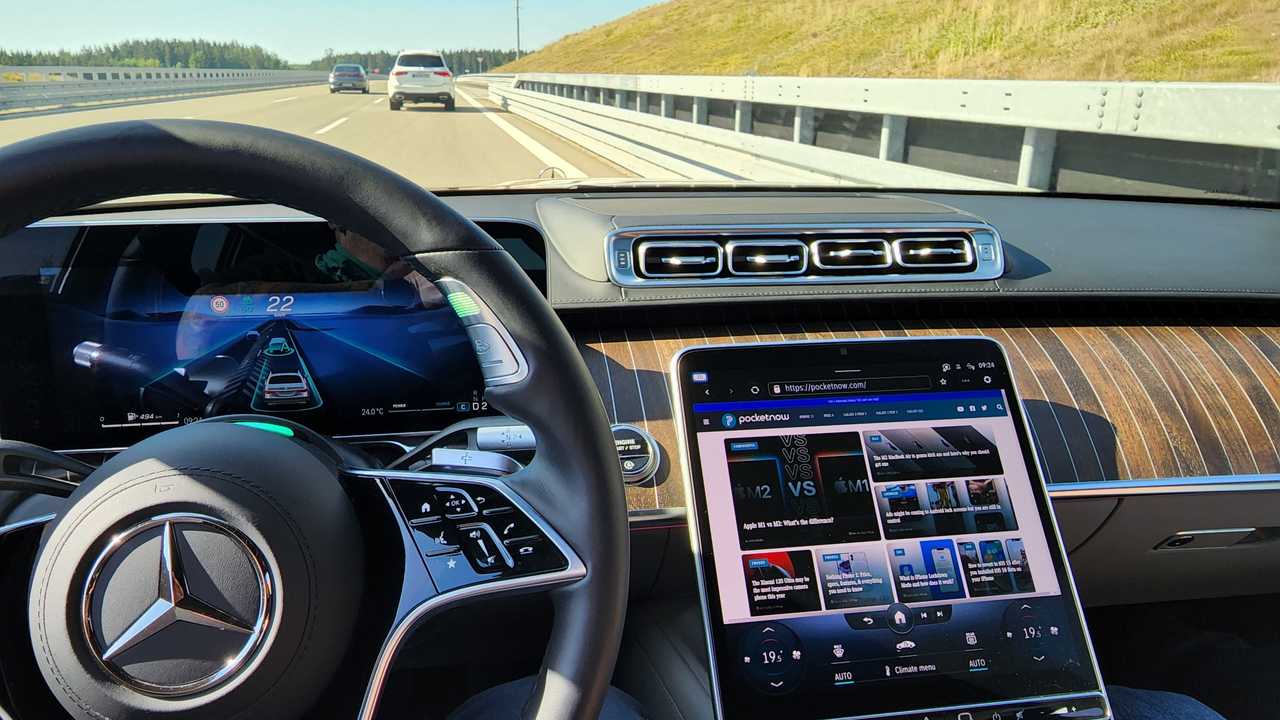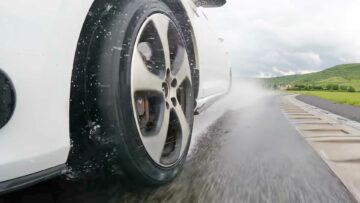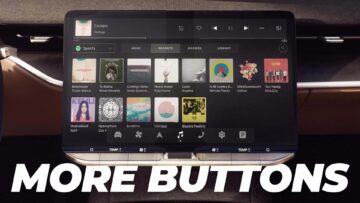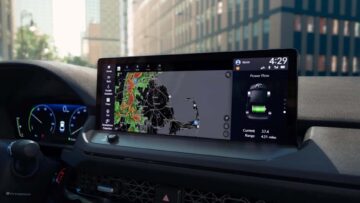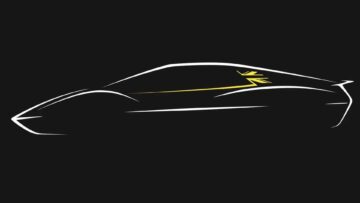Mercedes-Benz Drive Pilot was recently certified for use in Nevada, making it the first Level 3 advanced driver assistance system (ADAS) that’s road-legal in the US. Initially approved in Germany last year, California is next on Benz’s target markets. While Level 2 comprises a few “hands off” systems, Mercedes says its Level 3 ADAS is “eyes off,” meaning the driver can look away from the road, though still remain ready to take over at any time.
Level 2 ADAS – popularized by Tesla Autopilot – is now an option in many new cars, but Level 3 is harder to find, appearing only in the S Class Sedan and EQS in Europe and the Honda Legend in Japan. Mercedes-Benz’s Drive Pilot will arrive in the US in the second half of 2023 with pricing still up in the air; however, it costs €5,000 on the S-Class and €7,000 on the EQS in Germany ($5,320 and $7,448, respectively, at current exchange rates). This geofenced Level 3 system works at up to 40 miles per hour on select highways, and Mercedes-Benz will assume liability for incidents that arise from a fault in Drive Pilot.
In For The Long, Slow Haul
I was able to experience Drive Pilot firsthand as a driver on Mercedes’ Immendingen proving grounds in Germany last summer and as a passenger in Silicon Valley last month. My drive in Germany was meant to showcase how the Level 3 system reacts to different traffic situations in a controlled environment. In California, I was able to witness Drive Pilot in action on the freeway during rush hour without any safeguards.
It’s worth noting that the current 40-mph limit is regulatory, not technical. Mercedes plans to raise it to around 70 mph via an over-the-air update as federal and state laws allow. For now, 40 mph makes the system best suited for use in rush-hour traffic. To activate Drive Pilot, you first need to enable the Level 2 system (adaptive cruise control and steering assistance). You also need to have another vehicle in the lane ahead of you and be on a stretch of road that’s approved for Level 3 functionality – similar to GM’s Super Cruise, it’ll work on limited-access highways and interstates, primarily.

Mercedes cars with Drive Pilot have a pair of large silver buttons and LED lights mounted at the 9- and 3- o’clock positions on the steering wheel. The Level 3 system is available when those lights are white. Press either button and the system activates and the lights turn green. You can now take your eyes off the road, but you can’t close your eyes or obstruct the driver-attention camera mounted above the instrument panel.
You also have to be ready to take over within 10 seconds if Drive Pilot requires it. First, the lights will turn red, followed by an audible warning. Then, if you don’t react, the system will repeatedly tug at your seatbelt. Finally, if you still don’t take over, the car will activate its hazard lights and slowly come to a stop in its lane. You can cancel Drive Pilot at any time by pressing either silver button, turning the steering wheel, or using the pedals.
On the track in Germany, Mercedes simulated a few different traffic scenarios using multiple other vehicles, including trucks, while I was behind the wheel of an S-Class with Drive Pilot. The Level 3 system was able to handle stop-and-go traffic, erratic drivers cutting me off, and even cars broken down and stopped partially in my lane – all while I surfed the web on the center screen. It also detected emergency vehicles approaching from behind.
Meanwhile, on US Route 101 in California, I was in the front passenger seat of an EQS while a Mercedes representative was behind the wheel. Drive Pilot guided us around rush-hour traffic for several miles without drama, and to be honest, the whole experience was rather uneventful. Still, I was impressed with how confidently and smoothly the Level 3 system drove.
But while everything functioned as intended, there’s room for improvement. For example, Drive Pilot leaves a lot of space between your car and the vehicle in front of it, inviting other drivers to slide into the gap. When that inevitably happens, it pulls back and restores this space, leading to further incursions. I can see this being an issue in places where drivers are more aggressive, resulting in longer trips. Then again, we passed the time watching videos on the Hyperscreen, so does this really matter?
Drive Pilot will also ask you to take over if it detects unusual road debris, when the road is too wet, or when an emergency vehicle is approaching. It’s able to detect these exceptions thanks to a series of additional sensors, including lidar and stereo cameras in front, moisture sensors in the wheel wells, high-accuracy GPS, and an extra rear camera.
That additional rear camera is mounted high behind the rear windshield, on the driver side. It detects emergency vehicles by looking for flashing lights and is assisted by microphones that listen for the sound of sirens. The lidar and stereo cameras enable the computers to see in 3D. Cars equipped with Drive Pilot also include redundant EPS motor windings, redundant wheel rotation sensors, and an additional 12-volt battery for backup power.
Coming Soon To A Limited-Access Highway Near You
While the Drive Pilot hardware on German- and US-market cars is identical, there are some differences in the software. In the US, the Level 3 system can deal with narrower freeway lanes, longer and wider trucks, as well as lane-filtering motorcycles (it’s legal in California). Since the German Autobahn doesn’t always have shoulders, lanes are wider to enable the formation of an emergency vehicle corridor.
Ultimately, Drive Pilot does what it says on the box. It works well and lets you take your eyes off the road in stop-and-go traffic so you can enjoy watching videos during your commute – but only up to 40 mph. Right now, that’s a pretty major caveat, so it might not be worth the additional cost. But once that limit is lifted, I think this Level 3 system is going to be significantly more useful. And kudos to Mercedes for assuming liability.
- SEO Powered Content & PR Distribution. Get Amplified Today.
- Platoblockchain. Web3 Metaverse Intelligence. Knowledge Amplified. Access Here.
- Source: https://www.motor1.com/news/656719/mercedes-drive-pilot-level-3/
- :is
- $UP
- 000
- 1
- 10
- 100
- 2023
- 3d
- 70
- 9
- a
- Able
- above
- Action
- ADAs
- Additional
- advanced
- aggressive
- ahead
- AIR
- All
- always
- and
- Another
- approaching
- approved
- ARE
- around
- AS
- Assistance
- At
- Audible
- autopilot
- available
- back
- Backup
- backup power
- battery
- BE
- behind
- being
- BEST
- between
- Box
- Broken
- button
- by
- california
- camera
- cameras
- CAN
- car
- cars
- Center
- Certified
- class
- Close
- come
- Commute
- computers
- confidently
- content
- control
- controlled
- Cost
- Costs
- cruise
- Current
- cutting
- data
- deal
- detected
- differences
- different
- Doesn’t
- Dont
- down
- Drama
- drive
- driver
- drivers
- during
- either
- emergency
- enable
- enjoy
- Environment
- equipped
- Ether (ETH)
- Europe
- Even
- everything
- example
- exchange
- experience
- extra
- Eyes
- Federal
- few
- Finally
- Find
- First
- flashing
- followed
- For
- formation
- freeway
- from
- front
- functionality
- further
- gap
- German
- Germany
- going
- gps
- Green
- grounds
- Half
- handle
- happens
- Hardware
- Have
- High
- Highway
- highways
- How
- However
- HTTPS
- i
- identical
- image
- impressed
- improvement
- in
- include
- Including
- inevitably
- initially
- instrument
- interior
- inviting
- issue
- IT
- ITS
- Japan
- jpg
- KUDOS
- Label
- Lane
- large
- Last
- Last Year
- Laws
- leading
- Led
- Legal
- Lets
- Level
- liability
- lidar
- Lifted
- LIMIT
- Long
- longer
- Look
- looking
- Lot
- major
- MAKES
- Making
- many
- Markets
- Matter
- max-width
- meaning
- microphones
- might
- Month
- more
- Motor
- motorcycles
- multiple
- name
- Near
- Need
- NEVADA
- New
- next
- of
- on
- Option
- Other
- panel
- passed
- pilot
- Places
- plans
- plato
- Plato Data Intelligence
- PlatoData
- positions
- power
- press
- pretty
- pricing
- primarily
- Pulls
- raise
- Rates
- rather
- React
- Reacts
- ready
- recently
- Red
- remain
- REPEATEDLY
- representative
- requires
- resulting
- road
- Room
- Route
- rush
- s
- says
- scenarios
- Screen
- Second
- seconds
- sensors
- Series
- several
- showcase
- significantly
- Silicon
- Silicon Valley
- Silver
- similar
- since
- situations
- Slide
- slow
- Slowly
- smoothly
- So
- Software
- some
- Soon
- Sound
- Space
- State
- steering wheel
- Still
- Stop
- stopped
- summer
- Super
- system
- Systems
- Take
- Target
- test
- that
- The
- These
- Think
- time
- to
- too
- track
- traffic
- Trucks
- true
- TURN
- Turning
- unusual
- Update
- us
- use
- Valley
- value
- vehicle
- Vehicles
- via
- Videos
- warning
- watching
- web
- webp
- WELL
- Wells
- What
- Wheel
- while
- white
- wider
- will
- with
- within
- without
- witness
- Work
- works
- worth
- year
- Your
- zephyrnet

